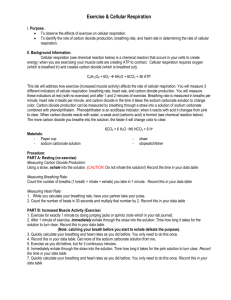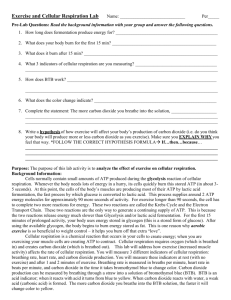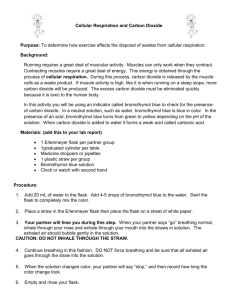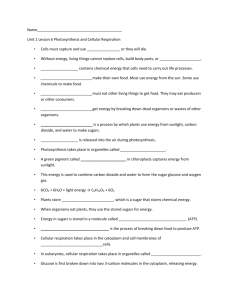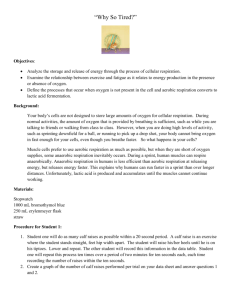Lab
advertisement
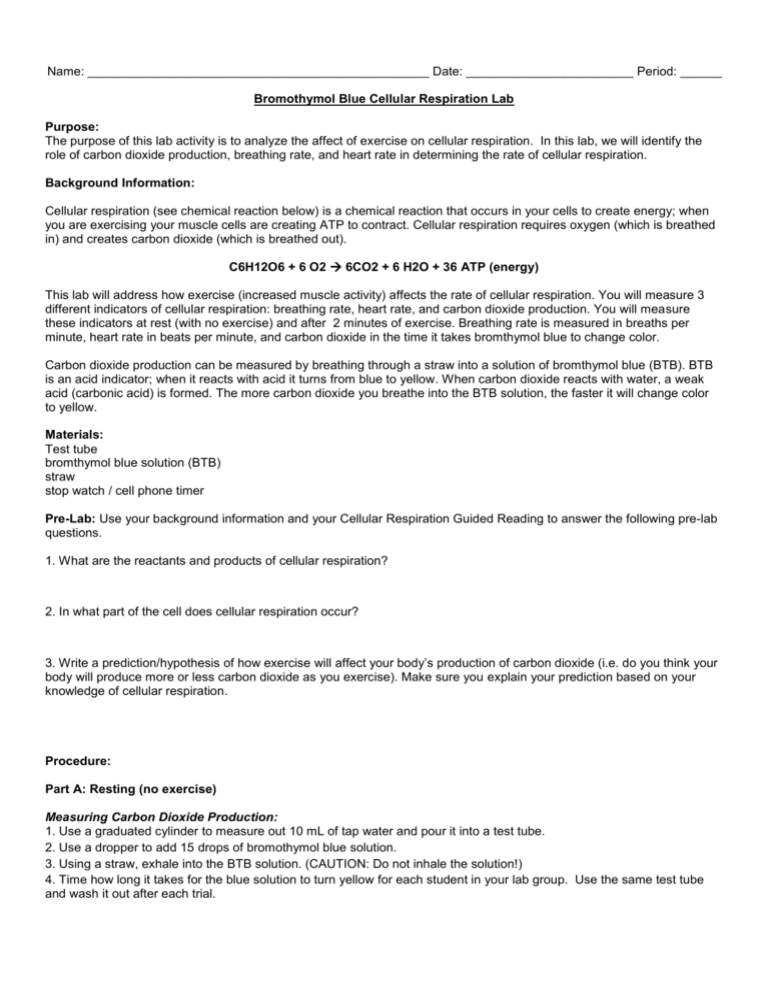
Name: _________________________________________________ Date: ________________________ Period: ______ Bromothymol Blue Cellular Respiration Lab Purpose: The purpose of this lab activity is to analyze the affect of exercise on cellular respiration. In this lab, we will identify the role of carbon dioxide production, breathing rate, and heart rate in determining the rate of cellular respiration. Background Information: Cellular respiration (see chemical reaction below) is a chemical reaction that occurs in your cells to create energy; when you are exercising your muscle cells are creating ATP to contract. Cellular respiration requires oxygen (which is breathed in) and creates carbon dioxide (which is breathed out). C6H12O6 + 6 O2 6CO2 + 6 H2O + 36 ATP (energy) This lab will address how exercise (increased muscle activity) affects the rate of cellular respiration. You will measure 3 different indicators of cellular respiration: breathing rate, heart rate, and carbon dioxide production. You will measure these indicators at rest (with no exercise) and after 2 minutes of exercise. Breathing rate is measured in breaths per minute, heart rate in beats per minute, and carbon dioxide in the time it takes bromthymol blue to change color. Carbon dioxide production can be measured by breathing through a straw into a solution of bromthymol blue (BTB). BTB is an acid indicator; when it reacts with acid it turns from blue to yellow. When carbon dioxide reacts with water, a weak acid (carbonic acid) is formed. The more carbon dioxide you breathe into the BTB solution, the faster it will change color to yellow. Materials: Test tube bromthymol blue solution (BTB) straw stop watch / cell phone timer Pre-Lab: Use your background information and your Cellular Respiration Guided Reading to answer the following pre-lab questions. 1. What are the reactants and products of cellular respiration? 2. In what part of the cell does cellular respiration occur? 3. Write a prediction/hypothesis of how exercise will affect your body’s production of carbon dioxide (i.e. do you think your body will produce more or less carbon dioxide as you exercise). Make sure you explain your prediction based on your knowledge of cellular respiration. Procedure: Part A: Resting (no exercise) Measuring Carbon Dioxide Production: 1. Use a graduated cylinder to measure out 10 mL of tap water and pour it into a test tube. 2. Use a dropper to add 15 drops of bromothymol blue solution. 3. Using a straw, exhale into the BTB solution. (CAUTION: Do not inhale the solution!) 4. Time how long it takes for the blue solution to turn yellow for each student in your lab group. Use the same test tube and wash it out after each trial. Measuring Breathing Rate: 1. Count the number of breaths (1 breath = inhale + exhale) you take in 1 minute. Repeat for each of your group members Measuring Heart Rate: 1. While you calculate your breathing rate, take your pulse by placing two fingers on the side of your neck. 2. Count the number of beats in 30 seconds and multiply that number by 2. Repeat for each of your group members. Part B: After Exercise Run up and down the stairs from the second floor to the first floor three times. Take the same three measurements you recorded before exercising after you finish running. Data Tables: Resting Measurement Group Member 1 Group Member 2 Group Member 3 Group Average Class Average Group Member 1 Group Member 2 Group Member 3 Group Average Class Average CO2 production (time it takes to turn yellow) Breathing Rate (breaths per minute) Heart Rate (beats per minute) After Exercise Measurement CO2 production (time it takes to turn yellow) Breathing Rate (breaths per minute) Heart Rate (beats per minute) Analysis Questions: Answer the following analysis questions thoroughly and accurately. 1. How did exercise affect the time needed for the solution to change color? Use class data to support your answer. 2. Explain why the color change occurred (How does BTB work?) 3. What can you conclude about the effect of exercise on the amount of carbon dioxide that is present in your exhaled breath? Use class data to support your answer. 4. What can you conclude about the effect of exercise on breathing rate? Use class data to support your answer. 5. What can you conclude about the effect of exercise on heart rate? Use class data to support your answer. 6. Discuss how and why the rate of cellular respiration is changing as muscle activity is increased. 7. Discuss how and why the breathing rate and heart rate change as muscle activity is increased. ***Lab revised from a similar lab designed by Loree Science***


